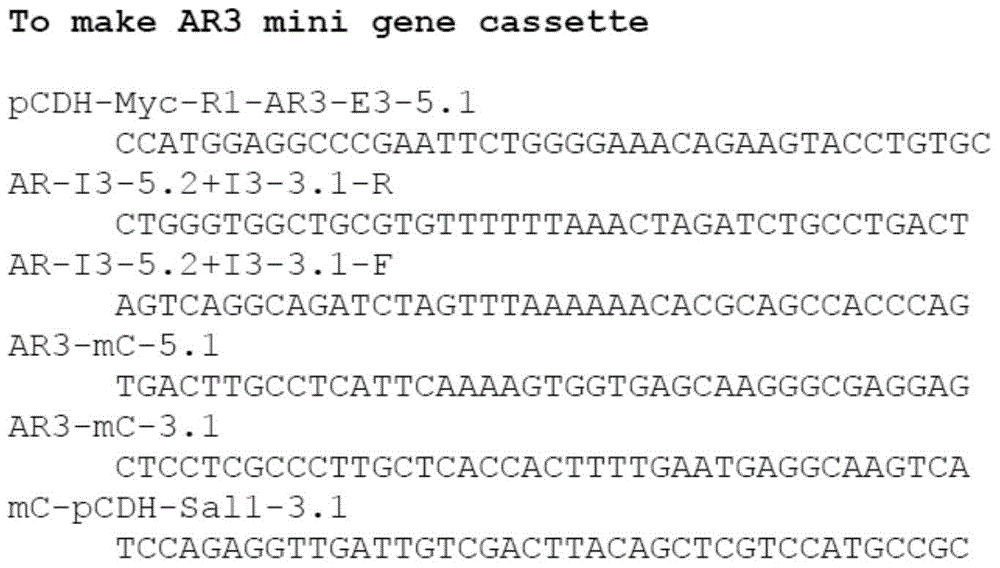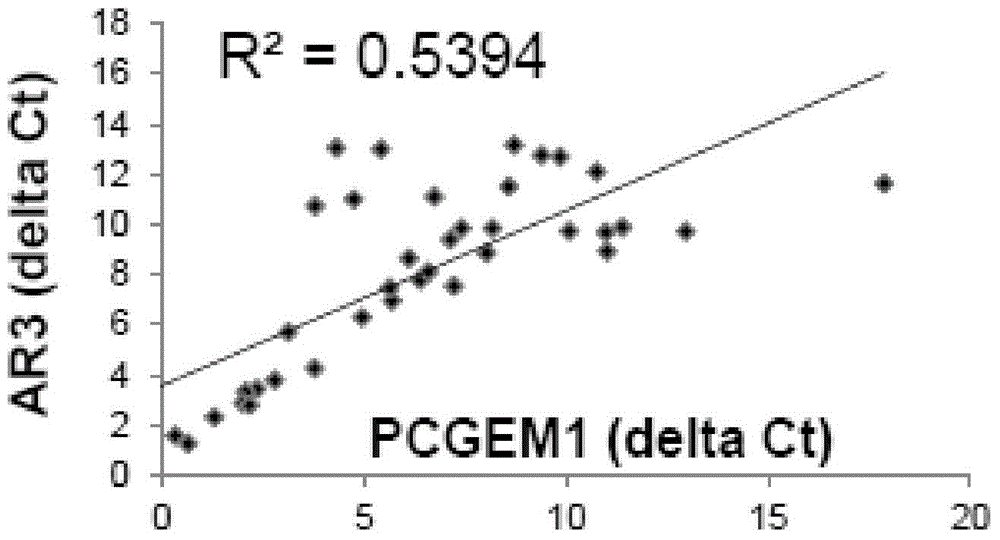In-vitro mini-reporter gene used for predicating androgen receptor posttranscriptional modification sites and application thereof
A post-transcriptional modification, androgen receptor technology, applied in the field of molecular biology, to achieve high efficiency, sensitivity and specificity, accurate verification and blocking, and practical clinical application value
- Summary
- Abstract
- Description
- Claims
- Application Information
AI Technical Summary
Problems solved by technology
Method used
Image
Examples
Embodiment 1
[0061] AR3 mini reporter gene plasmid ( figure 1 ), which consists of the following primer sequence clones:
[0062] pCDH-Myc-R1-AR3-E3-5.1 (SEQ ID NO.1):
[0063] CCATGGAGGCCCGAATTCTGGGGAAACAGAAGTACCTGTGC
[0064] AR-I3-5.2+I3-3.1-R (SEQ ID NO.2):
[0065] CTGGGTGGCTGCGTGTTTTTTAAACTAGATCTGCCTGACT
[0066] AR-I3-5.2+I3-3.1-F (SEQ ID NO.3):
[0067] AGTCAGGCAGATCTAGTTTAAAAAACACGCAGCCACCCAG
[0068] AR3-mC-5.1 (SEQ ID NO.4):
[0069] TGACTTGCCTCATTCAAAAGTGGTGAGCAAGGGCGAGGAG
[0070] AR3-mC-3.1 (SEQ ID NO.5):
[0071] CTCCTCGCCCTTGCTCACCACTTTTGAATGAGGCAAGTCA
[0072] mC-pCDH-Sal1-3.1 (SEQ ID NO.6):
[0073] TCCAGAGGTTGATTGTCGACTTACAGCTCGTCCATGCCGC
[0074] The isoform AR3 mini-reporter gene (AR3mini gene cassette mCherry reporter) of the androgen receptor (AR) was constructed according to the following method:
[0075] PCR method was used to amplify the exon exon3 (E3) and part of the intron (about 2.3kb) sequence of AR using human genomic DNA as a template. The primer...
Embodiment 2
[0076] Embodiment 2 Real-time quantitative PCR detects the expression levels of PCGEM1 and AR3 ( figure 2 )
[0077] The expression level of a target gene can be routinely determined using, eg, quantitative PCR, ribonuclease protection assays. The following cell types are provided for example, but other cell types can be routinely used provided the target is expressed in the cell type of choice.
[0078] LNCaP cells are cultured in a suitable medium as described below and maintained at 37 °C, 95-98% humidity and 5% CO 2 middle. When cultured under hypoxia or hypoxia, O 2 Levels remain at 1-2% or 0-0.5%, respectively. Cells were routinely passaged 2-3 times a week.
[0079] (1) Collect cells.
[0080] (2) Extracting the total RNA in the cells. The RNA extraction kit (AM1560) of Ambion Company was used, and the operation was performed according to the instructions of the kit.
[0081](3) Take 100ng of total RNA and perform reverse transcription.
[0082] (4) Take the p...
Embodiment 3
[0092] Example 3 PCGEM1 participates in the regulation of AR3 post-transcriptional modification expression ( image 3 )
[0093] (1) LNCaP cells were cultured with 1640 medium plus 10% FBS until the cell density reached 50%.
[0094] (2) Use RNA transfection reagent to transfect PCGEM1-LNA and NC according to the routine operation method in the manual, and the final concentration reaches 50 nM. Wherein, the PCGEM1-LNA sequence is A+T+T+CCCCTCAGA+A+ATCTCAGGGCTT+G+T+C, wherein + is selected from any one of β-D-oxygen-LNA nucleotide analogues. The purpose of transfecting PCGEM1-LNA is to observe the effect on AR3 expression by down-regulating the expression of PCGEM1.
[0095] (3) After the transfection time reaches 12 hours, replace with fresh medium and continue to culture for 24 hours.
[0096] (4) Aspirate the medium, collect the cells and extract the total RNA, and detect the expression of AR3 regulated by PCGEM1 by northtern. For the specific operation method, see "Zhang...
PUM
 Login to View More
Login to View More Abstract
Description
Claims
Application Information
 Login to View More
Login to View More - R&D
- Intellectual Property
- Life Sciences
- Materials
- Tech Scout
- Unparalleled Data Quality
- Higher Quality Content
- 60% Fewer Hallucinations
Browse by: Latest US Patents, China's latest patents, Technical Efficacy Thesaurus, Application Domain, Technology Topic, Popular Technical Reports.
© 2025 PatSnap. All rights reserved.Legal|Privacy policy|Modern Slavery Act Transparency Statement|Sitemap|About US| Contact US: help@patsnap.com



